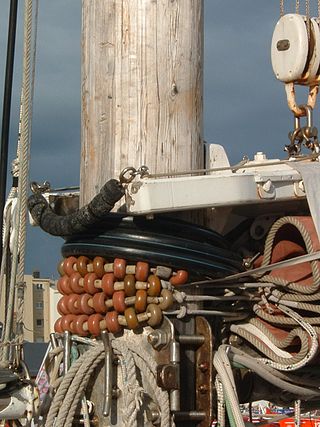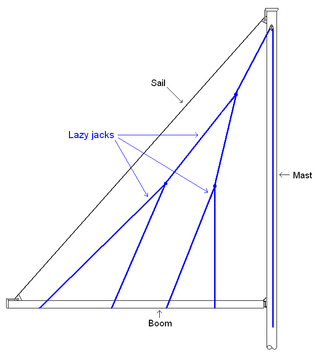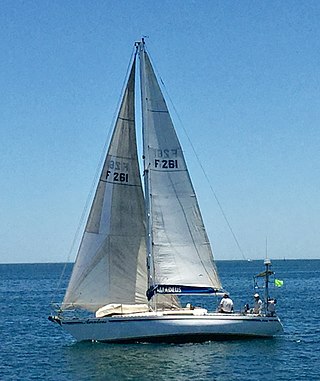
A spinnaker is a sail designed specifically for sailing off the wind on courses between a reach to downwind. Spinnakers are constructed of lightweight fabric, usually nylon, and are often brightly colored. They may be designed to perform best as either a reaching or a running spinnaker, by the shaping of the panels and seams. They are attached at only three points and said to be flown.

Reefing reduces the area of a sail, usually by folding or rolling one edge of the canvas in on itself and attaching the unused portion to a spar or a stay, as the primary measure to preserve a sailing vessel's stability in strong winds. Restoring full sail area is termed shaking out a reef.

The spritsail is a four-sided, fore-and-aft sail that is supported at its highest points by the mast and a diagonally running spar known as the sprit. The foot of the sail can be stretched by a boom or held loose-footed just by its sheets. A spritsail has four corners: the throat, peak, clew, and tack. The Spritsail can also be used to describe a rig that uses a spritsail.

The Mutineer 15 is a 15-foot (4.6 m) long fractional sloop sailboat currently manufactured by Nickels Boat Works. It has a dinghy centerboard hull, no ballast, and displaces 410 pounds. The Mutineer 15 has a 6-foot (1.8 m) beam, maximum draw of 4.08 feet (1.24 m), and has 150 square feet (14 m2) of sail area. The Mutineer 15 is commonly used for both day sailing and class racing. The Mutineer 15 can be comfortably sailed as a day sailer with a crew of four, but can also be raced with a crew of two, or even single-handed by semi-experienced to experienced sailors.

Parrel beads are an element of sailing rigging. They act as roller bearings on a parrel, which is a rope or wire strop that typically fastens one spar to another along which it must have some freedom of movement. An example of this is at the jaws of a gaff on a gaff rigged or gunter rigged craft. This allows the gaff to slide up and down the mast as sail is hoisted or lowered, and allows some rotation around the mast as the sail is sheeted in and out to allow for different wind directions. Another example is on the tack of a spinnaker rigged over a furled jib.
A mast-aft rig is a sailboat sail-plan that uses a single mast set in the aft half of the hull. The mast supports fore-sails that may consist of a single jib, multiple staysails, or a crab claw sail. The mainsail is either small or completely absent. Mast-aft rigs are uncommon, but are found on a few custom, and production sailboats.

Roller furling is a method of furling a yacht's staysail by rolling the sail around a stay. Roller furling is typically used for foresails such as jibs or genoas.

Lazy jacks are a type of rigging which can be applied to a fore-and-aft rigged sail to assist in sail handling during reefing and furling. They consist of a network of cordage which is rigged to a point on the mast and to a series of points on either side of the boom; these lines form a cradle which helps to guide the sail onto the boom when it is lowered, reducing the crew needed to secure the sail. Lazy jacks are most commonly associated with Bermuda rigged sails, although they can be used with gaff rigged sails and with club-footed jibs. Blocks and rings may be part of some lazyjacks.

A wingsail, twin-skin sail or double skin sail is a variable-camber aerodynamic structure that is fitted to a marine vessel in place of conventional sails. Wingsails are analogous to airplane wings, except that they are designed to provide lift on either side to accommodate being on either tack. Whereas wings adjust camber with flaps, wingsails adjust camber with a flexible or jointed structure. Wingsails are typically mounted on an unstayed spar—often made of carbon fiber for lightness and strength. The geometry of wingsails provides more lift, and a better lift-to-drag ratio, than traditional sails. Wingsails are more complex and expensive than conventional sails.
Windmills are powered by their sails. Sails are found in different designs, from primitive common sails to the advanced patent sails.

PocketShip is a stitch-and-glue pocket cruiser sailboat designed by John C. Harris of Chesapeake Light Craft.

A masthead rig on a sailing vessel consists of a forestay and backstay both attached at the top of the mast.

The C&C Custom 67 is a Canadian sailboat, that was designed by Robert W. Ball of C&C Yachts and was launched and named Archangel in September 1980. She remains the largest pleasureboat commission ever received by C&C, and epitomized a trend within C&C during the later 1970s and early 1980s toward more cruising-oriented designs under George Cuthbertson's direction, a trend best illustrated by the development of the Landfall series.
The Hunter 38 is an American sailboat that was designed by Glenn Henderson as a cruiser and first built in 2004.
The Hunter 41 is an American sailboat that was designed by Glenn Henderson as a cruiser and first built in 2004.

The Hobie Bravo is an American catamaran sailing dinghy that was designed by Hobie Cat in 2000 and first built in 2001. The design is intended for sailing from beaches by one or two people.
A solent refers to a sail and rigging system on sailboats, typically sloops. Sailors, particularly British sailors, often refer to a 100% jib as a Solent, because its smaller size is preferable when sailing in the strong winds found in the Solent between the Isle of Wight and Britain. The common use of roller-furling headsails, or genoas, on modern cruising yachts allows the jib to be reduced in size, but partially-furled sails lack the efficiency of a sail that is actually cut to a smaller size. Accordingly, it is preferable to fly a separate, smaller jib—the solent—instead.
The Ideal 18 is a Canadian trailerable sailboat that was designed by Bruce Kirby as a one design racer and first built in 1989.
The O'Day 192 is an American trailerable sailboat that was designed by John Deknatel of C. Raymond Hunt Associates, as a pocket cruiser and first built in 1984.

The Harbor 20 is an American trailerable sailboat that was designed by W. D. Schock Corp's Steve Schock as a day sailer and one design club racer. It was first built in 1997.












